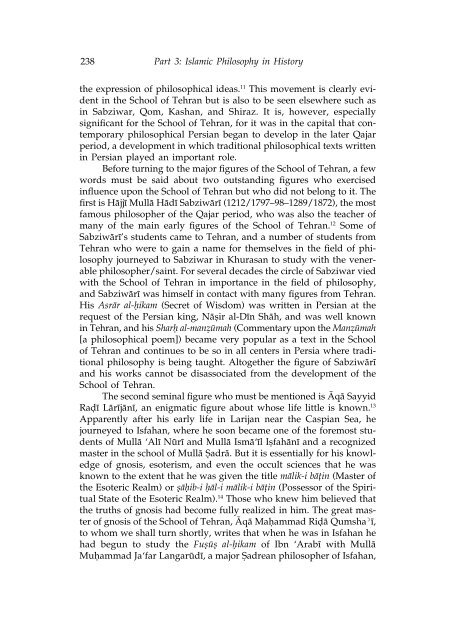Islamic Philosophy from Its Origin to the Present: Philosophy in the ...
Islamic Philosophy from Its Origin to the Present: Philosophy in the ...
Islamic Philosophy from Its Origin to the Present: Philosophy in the ...
Create successful ePaper yourself
Turn your PDF publications into a flip-book with our unique Google optimized e-Paper software.
238 Part 3: <strong>Islamic</strong> <strong>Philosophy</strong> <strong>in</strong> His<strong>to</strong>ry<br />
<strong>the</strong> expression of philosophical ideas. 11 This movement is clearly evident<br />
<strong>in</strong> <strong>the</strong> School of Tehran but is also <strong>to</strong> be seen elsewhere such as<br />
<strong>in</strong> Sabziwar, Qom, Kashan, and Shiraz. It is, however, especially<br />
significant for <strong>the</strong> School of Tehran, for it was <strong>in</strong> <strong>the</strong> capital that contemporary<br />
philosophical Persian began <strong>to</strong> develop <strong>in</strong> <strong>the</strong> later Qajar<br />
period, a development <strong>in</strong> which traditional philosophical texts written<br />
<strong>in</strong> Persian played an important role.<br />
Before turn<strong>in</strong>g <strong>to</strong> <strong>the</strong> major figures of <strong>the</strong> School of Tehran, a few<br />
words must be said about two outstand<strong>in</strong>g figures who exercised<br />
<strong>in</strong>fluence upon <strong>the</strong> School of Tehran but who did not belong <strong>to</strong> it. The<br />
first is Håjj¥ Mullå Håd¥ Sabziwår¥ (1212/1797–98–1289/1872), <strong>the</strong> most<br />
famous philosopher of <strong>the</strong> Qajar period, who was also <strong>the</strong> teacher of<br />
many of <strong>the</strong> ma<strong>in</strong> early figures of <strong>the</strong> School of Tehran. 12 Some of<br />
Sabziwår¥’s students came <strong>to</strong> Tehran, and a number of students <strong>from</strong><br />
Tehran who were <strong>to</strong> ga<strong>in</strong> a name for <strong>the</strong>mselves <strong>in</strong> <strong>the</strong> field of philosophy<br />
journeyed <strong>to</strong> Sabziwar <strong>in</strong> Khurasan <strong>to</strong> study with <strong>the</strong> venerable<br />
philosopher/sa<strong>in</strong>t. For several decades <strong>the</strong> circle of Sabziwar vied<br />
with <strong>the</strong> School of Tehran <strong>in</strong> importance <strong>in</strong> <strong>the</strong> field of philosophy,<br />
and Sabziwår¥ was himself <strong>in</strong> contact with many figures <strong>from</strong> Tehran.<br />
His Asrår al-÷ikam (Secret of Wisdom) was written <strong>in</strong> Persian at <strong>the</strong><br />
request of <strong>the</strong> Persian k<strong>in</strong>g, Nå∑ir al-D¥n Shåh, and was well known<br />
<strong>in</strong> Tehran, and his Shar÷ al-manz.¶mah (Commentary upon <strong>the</strong> Manz.¶mah<br />
[a philosophical poem]) became very popular as a text <strong>in</strong> <strong>the</strong> School<br />
of Tehran and cont<strong>in</strong>ues <strong>to</strong> be so <strong>in</strong> all centers <strong>in</strong> Persia where traditional<br />
philosophy is be<strong>in</strong>g taught. Al<strong>to</strong>ge<strong>the</strong>r <strong>the</strong> figure of Sabziwår¥<br />
and his works cannot be disassociated <strong>from</strong> <strong>the</strong> development of <strong>the</strong><br />
School of Tehran.<br />
The second sem<strong>in</strong>al figure who must be mentioned is ≈qå Sayyid<br />
Ra∂¥ Lår¥jån¥, an enigmatic figure about whose life little is known. 13<br />
Apparently after his early life <strong>in</strong> Larijan near <strong>the</strong> Caspian Sea, he<br />
journeyed <strong>to</strong> Isfahan, where he soon became one of <strong>the</strong> foremost students<br />
of Mullå ‘Al¥ N¨r¥ and Mullå Ismå‘¥l I∑fahån¥ and a recognized<br />
master <strong>in</strong> <strong>the</strong> school of Mullå |adrå. But it is essentially for his knowledge<br />
of gnosis, esoterism, and even <strong>the</strong> occult sciences that he was<br />
known <strong>to</strong> <strong>the</strong> extent that he was given <strong>the</strong> title målik-i bå†<strong>in</strong> (Master of<br />
<strong>the</strong> Esoteric Realm) or ƒå÷ib-i ÷ål-i målik-i bå†<strong>in</strong> (Possessor of <strong>the</strong> Spiritual<br />
State of <strong>the</strong> Esoteric Realm). 14 Those who knew him believed that<br />
<strong>the</strong> truths of gnosis had become fully realized <strong>in</strong> him. The great master<br />
of gnosis of <strong>the</strong> School of Tehran, ≈qå Ma±ammad Ri∂å Qumsha˘¥,<br />
<strong>to</strong> whom we shall turn shortly, writes that when he was <strong>in</strong> Isfahan he<br />
had begun <strong>to</strong> study <strong>the</strong> Fuƒ¶ƒ al-÷ikam of Ibn ‘Arab¥ with Mullå<br />
Mu±ammad Ja‘far Langar¨d¥, a major |adrean philosopher of Isfahan,

















